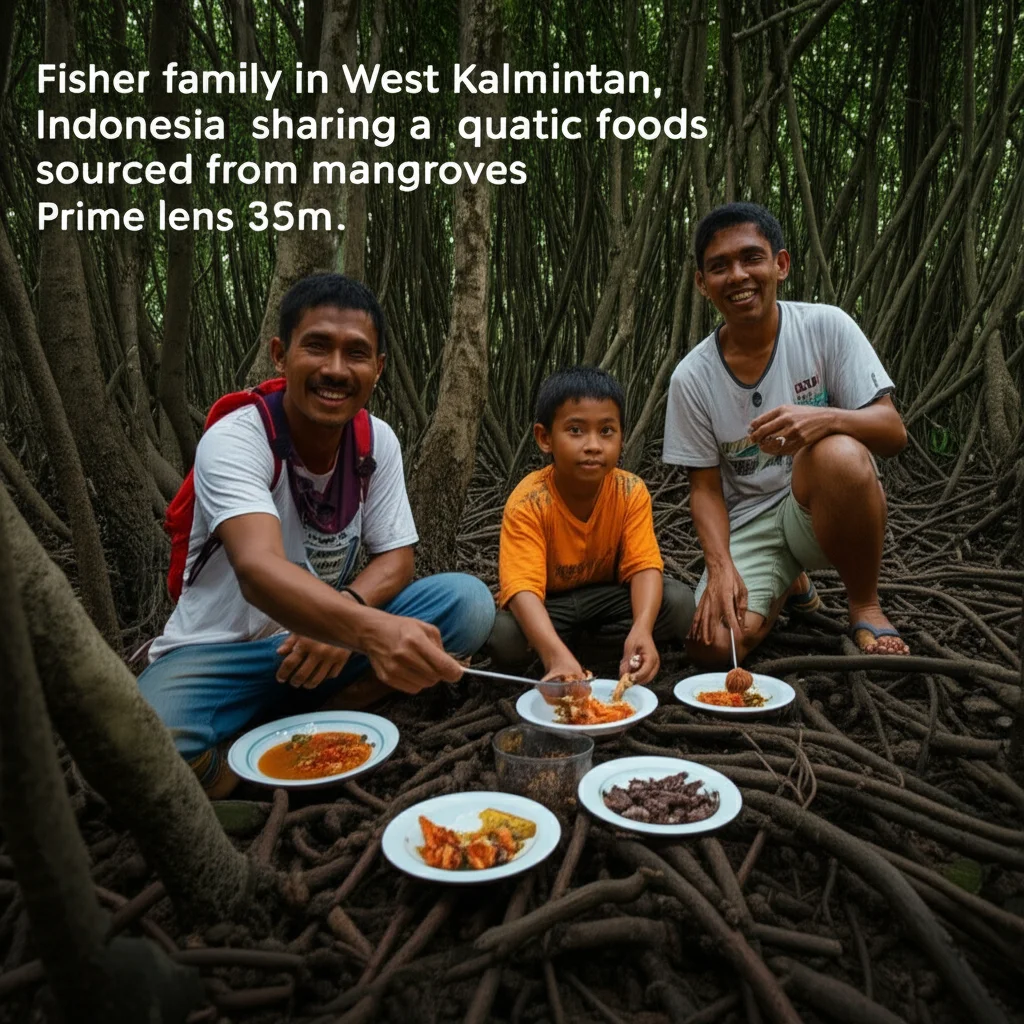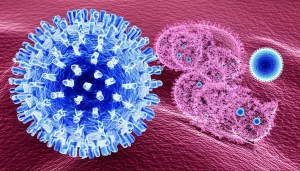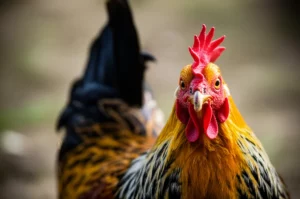Mangrove Munchies: How Aquatic Foods Fuel Families in West Kalimantan
Hey Folks, Let’s Talk About Food Security!
You know, across the globe, way too many people are still grappling with food insecurity and not getting enough of the good stuff – those vital nutrients our bodies need. We’re talking about billions of people facing moderate to severe food insecurity, and sadly, millions potentially experiencing hunger. It’s a big deal, especially for kids under five, where micronutrient deficiencies like not enough vitamin A, zinc, or iron are surprisingly common. These deficiencies can really mess with a child’s development and well-being, and frankly, impact adults and whole societies too. Plus, with the rise of the “double burden” of malnutrition – where undernutrition and overnutrition coexist – things get even more complicated for health systems, particularly in low- and middle-income countries (LMICs).
Indonesia’s Nutritional Landscape
Now, let’s zoom in on Indonesia. It’s this amazing archipelagic country with thousands of islands and incredible coastal ecosystems, including vast mangrove forests. Indonesia has seen rapid changes lately, with urbanization and globalization shaking up the food scene. This has contributed to both under- and over-nutrition issues. Get this: Indonesia has one of the highest rates of stunting in the world, affecting nearly a third of kids under five! Plus, many women of reproductive age are anemic, and a chunk of the population faces food insecurity. West Kalimantan, where our study took place, actually has some of the highest rates of undernutrition in the country. It’s clear that finding sustainable, local solutions is super important, especially with population growth and climate change impacts.
Enter Aquatic Foods: Tiny Packages of Power
Lately, there’s been a growing buzz about how aquatic foods – that’s finfish, shellfish, plants, and anything else from water environments – can be a real game-changer in fighting food and nutrition insecurity, especially in places like LMICs. And for good reason! Aquatic foods are packed with nutrients, like calcium, zinc, iron, vitamin A, and vitamin B12. Fish, in particular, are awesome sources of fatty acids, which are crucial for kids’ brain development. Small-scale fisheries globally contribute a significant chunk of the world’s aquatic food nutrients, feeding millions. Research is showing that communities near the coast, relying on these local catches, can get a huge boost to their nutrient intake, helping to tackle those pesky deficiencies.
Mangroves: More Than Just Trees
In Indonesia, coastal communities really lean on marine resources and ecosystems like mangroves for their food and nutrition security. Fish and other aquatic foods are a staple protein source. But here’s the thing: while we know aquatic foods are important, there hasn’t been a ton of research specifically looking at the nutrient value of foods *sourced from mangroves*, especially in Indonesia. This means these incredible food systems might be getting overlooked in important policies. Turns out, communities near dense mangroves in Indonesia consume significantly more fish than those who aren’t, showing that mangroves directly contribute to local diets and food security. In Kubu Raya, West Kalimantan, mangroves are a vital local food system, offering tons of edible species and supporting livelihoods.
Our Little Deep Dive in West Kalimantan
So, that’s where we came in! We wanted to really dig into the nutrient contribution of aquatic foods from mangroves to fisher households in a specific community in West Kalimantan. We asked a few key questions: What aquatic foods are folks gathering from mangroves? What nutrients are they getting from them? And does this change depending on the season? For this study, we focused on finfish and shellfish. This work builds on existing knowledge, highlighting the potential role of mangrove systems in supporting food and nutrition security, not just through income, but directly through food.
How We Did It (A Peek Behind the Scenes)
We set up a case study in Batu Ampar village, right next to a huge mangrove system. We worked with households involved in fishing, especially those with kids. We used a method called a seven-day weighed food record, which is kind of the gold standard for dietary assessment, but we adapted it for households because people here often eat together. We did this *twice* over a year – once in the wet season (locally called Barat, lots of rain and wind) and once in the dry season (Selatan, May to September) – to see how things changed seasonally. We teamed up with researchers from a local university in West Kalimantan, which was super important for making sure we did things right and respectfully, building trust with the community. We trained household members on how to weigh the food and record everything. We also asked them if the week we recorded was typical for them and why consumption might have changed. We then crunched the numbers, looking at nutrient composition data for the species they ate and comparing it to recommended nutrient intakes (RNIs) for different age and sex groups in Indonesia.

What We Found: Consumption Patterns
Okay, so what did the data tell us? We had 59 households participate in the wet season and 54 in the dry season (a few couldn’t continue). The average household size was around 5.5 people. Interestingly, folks ate a greater *variety* of aquatic foods in the wet season (50 species!) compared to the dry season (33 species). However, they consumed *more meals* containing aquatic foods in the dry season (390 meals) than in the wet season (337 meals). The total quantity consumed per person per day was also higher in the dry season. Most of the aquatic food came from the surrounding mangroves, not the market.
We also looked at who was sourcing the food. In the dry season, women and men often went together. But in the wet season, our data suggested they sourced food separately. Men tended to source more from the mangroves in both seasons compared to women. When it came to the market, men sourced less than women in the wet season but about the same in the dry season.
The most frequently consumed species were pretty consistent across both seasons, including some shellfish like giant freshwater shrimp and regular shrimp, and several finfish species like eeltail catfish, spotted scar/butterfish, and marine catfish. Marine catfish was the most consumed species in the wet season, while spotted scar/butterfish took the top spot in the dry season.
What We Found: Nutrient Contributions
Now for the really exciting part – the nutrients! We looked at seven key nutrients: calcium, iron, selenium, zinc, vitamin A, omega-3 essential fatty acids, and protein. And guess what? Aquatic foods from the mangroves contributed to *all* of them! The contribution was particularly high for:
- Selenium: This one was off the charts! Aquatic foods contributed way over 100% of the average RNI in both seasons (127% in wet, 193% in dry).
- Protein: A solid contribution, higher in the dry season (35%) than the wet (27%).
- Omega-3 Essential Fatty Acids: Pretty stable contribution in both seasons, around 21% of the RNI.
- Zinc: Higher in the dry season (17%) compared to the wet (10%).
Other nutrients showed seasonal shifts too. Calcium and vitamin A contributions increased from wet to dry season (Calcium: 8% to 10%; Vitamin A: 4% to 7%). Iron was the only one that slightly decreased, but only by a tiny bit (11% to 10%).
When we looked at which species contributed the most to nutrients, spotted scar/butterfish was a big player, especially in the dry season, contributing significantly to most nutrients (except vitamin A). Marine catfish and chub mackerels also made important contributions, particularly to protein, omega-3s, iron, and calcium.

Why the Seasonal Differences?
So, why did consumption and nutrient intake vary between seasons? The households told us! The main reasons for *lower* consumption in the wet season included:
- Bad weather (rain, lightning, wind) making fishing difficult.
- Working on other jobs.
- Family members being sick.
- Higher fish prices.
- Problems with fishing gear.
In contrast, the reasons for *higher* consumption in the dry season were mainly:
- Greater availability of aquatic foods.
- Catching more fish.
- Spending more time fishing.
Income and dietary preferences also played a role for some. It seems weather and availability are major drivers of seasonal changes in aquatic food intake here.
Putting It All Together: Why This Matters
For too long, aquatic foods, and especially those from mangrove systems, haven’t gotten the attention they deserve in public health and nutrition discussions. Our findings really underscore that these foods are providing essential nutrients and contributing significantly to the food and nutrition security of people in places like Batu Ampar. The sheer number of times households consumed these foods shows they are a staple part of the diet. This is a big deal, especially considering Indonesia’s nutritional challenges and the fact that Asia is a massive consumer of aquatic foods globally. It highlights a huge opportunity to use these locally available, nutrient-rich resources to combat malnutrition.
Indonesia actually has the largest area of mangroves in the world! This presents a unique chance to manage these ecosystems in a way that benefits both the environment and the people who rely on them for food. There are already examples of integrating food security into marine policies in Indonesia, like the “Love Eating Fish” campaign. We think there’s real potential to do the same for mangroves, making sure their value as a food system is recognized alongside their ecological importance.
Like many food systems, especially in rural coastal areas, seasonality clearly impacts nutrient intake here. While there was more variety in the wet season, the higher quantity consumed in the dry season meant higher overall nutrient intake for most things we looked at. Understanding these seasonal shifts is crucial if we want to use aquatic foods effectively in nutrition interventions.

Nutrient Deep Dive: Selenium, Protein, Iron, and Vitamin A
Let’s talk a bit more about some specific nutrients. That super high selenium intake from aquatic foods is pretty neat. While we need selenium in small amounts, and too much can be an issue, other studies in places like Zambia have also found high selenium contributions from local aquatic foods. It seems many species found in these environments are just naturally rich in it.
Protein is another vital one, especially for preventing stunting in young children, which is a major focus for the Indonesian government. Our study shows that mangrove aquatic foods are a really important source of animal protein for these households, contributing a good percentage of the RNI. Finding sustainable ways to boost protein intake is key, and these local foods are clearly part of the answer.
Iron deficiency is also a big public health concern in Indonesia, particularly for women and young children. While the iron contribution from aquatic foods wasn’t as high as selenium or protein in our study, it still added to the RNI, with species like chub mackerels being notable contributors. Even if the contribution isn’t massive, getting iron from diverse sources, including these aquatic foods, is important across different age groups.
Vitamin A deficiency is another global issue, and increasing intake of vitamin A-rich foods is a key strategy. Some studies, particularly from Bangladesh, have shown that small indigenous fish species can be incredibly rich in vitamin A. Our findings showed a lower contribution to vitamin A RNI compared to other nutrients. This might be because the most consumed species in our study were larger fish, and often only the fillets are eaten, while vitamin A is often concentrated in organs like the liver (which we didn’t account for). If there are specific vitamin A-rich species in the West Kalimantan mangroves, promoting their consumption could be beneficial, but we’d need to consider harvesting and climate factors.
Looking Ahead: Integrating Food and Conservation
This study is just a starting point, a case study in one community. But it gives us a really valuable initial look at how mangrove aquatic foods contribute to nutrition. There’s so much more to explore in different contexts and with different groups. The fact that the latest global report on mangroves finally acknowledged their food and nutrition security benefits is a huge step! This, combined with other research showing the value of mangroves for food and livelihoods, means these benefits absolutely *must* be considered in mangrove management and conservation plans. And crucially, the local communities who live and breathe these ecosystems need to be at the table in policy-making, bringing their invaluable knowledge.
Indonesia is also heavily invested in mangrove planting and ‘blue carbon’ initiatives, which are important for climate change. As global interest in blue carbon financing grows, it’s critical to understand the full value of mangroves, including their role as a food system. Communities need to weigh the potential benefits of things like carbon credits against the risk of losing access to a vital food source if not managed carefully. We need integrated strategies that consider both conservation and the food and nutrition benefits communities get from mangroves.
A Few Caveats (Keeping It Real)
Okay, full disclosure, this was a case study in one spot, so it’s not necessarily representative of *all* mangrove-dependent communities everywhere. We also used a specific sampling method that might introduce some bias. And because we collected data at the household level, we couldn’t account for individual portion sizes, which means nutrient intake for specific individuals (like kids) might be slightly different than the average we calculated. We also relied on existing nutrient databases, which don’t always have data for every single species or might use predictive models rather than lab analysis, and the fish analyzed might not be from Indonesia specifically. Plus, we didn’t collect data on other food groups, so we can’t say how aquatic foods stack up against other protein sources in their overall diet.
Despite these points, the takeaway is clear: given Indonesia’s vast mangroves and its nutrition challenges, the aquatic foods harvested through traditional methods are a vital part of the solution. Integrating the value of these foods into nutrition programs and marine/mangrove conservation strategies just makes sense. Research is increasingly showing the power of aquatic foods to nourish populations, especially those living near water. Our study confirms that in West Kalimantan, these foods are staples, supporting essential nutrient intake. It’s time for policies and management to look beyond just conservation and fully embrace the incredible food system value that communities derive from mangroves. We really hope this encourages collaboration between local communities, scientists, and organizations to develop strategies that benefit both the mangroves and the people who call them home and rely on them for sustenance.
Source: Springer







